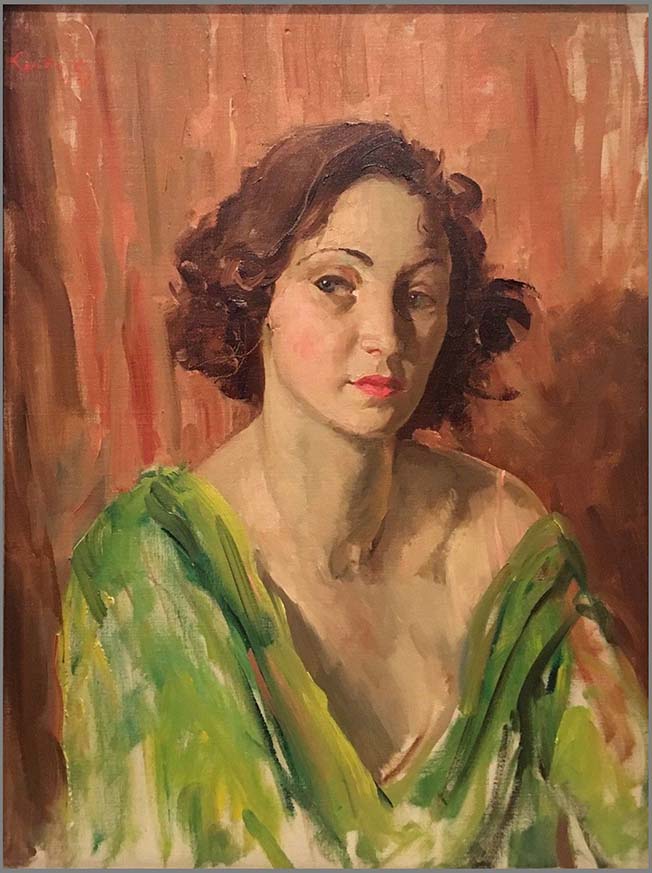Edward Lintott
1975-1951
After a period of versatile training as a painter, London-born Edward Barnard Lintott (1875-1951) interrupted his career with related but non-artistic political duties, acting as the British Ambassador to Russia's secretary. Following his return to art, he demonstrated definite ability in portraiture, still-life, and a variety of other subjects. Lintott traveled widely and enjoyed representation by exclusive art galleries. Although he executed some unusually sensitive works prior to World War I, the bulk of his artistic productivity was later (Clayton and Liberatore, 1970). Lintott, born in London on 11 December 1875, studied in England and then crossed the Channel to continue at the Sorbonne in Paris. He sought more traditional instruction from Jean-Paul Laurens and Benjamin Constant at the Académie Julian. By the first year of the century he was enrolled at the Ecole des Beaux-Arts where he refined his ability to draw the human figure (Bakker, 1975, p. 4). Although Lintott was a talented painter, diversified interests involved him in peripheral art activities during his ten-year stay in Paris.
Lintott executed portrait studies and works in the plein-air manner during various sketching trips. After his return to his native London as a well-trained professional, his opinion was sought by friends and he eventually gave up painting to a great extent to accept various government appointments as an art advisor. Lintott was also instrumental in fund-raising for Belgian refugee artists in World War I. As Secretary to the British Ambassador to Russia, he managed to paint by executing portraits of distinguished friends. Like Louis Kronberg before him, Lintott became fascinated with the ballet and theater as subjects for painting. "The artist-diplomat made much use of the Chancery and Embassy box at the Marinsky Theatre . . . and became personally acquainted with many members of the 'Corps de Ballet.'" (see "Lintott Paints the Ballet and the Theatre," 1939). His theatrical imagery is competently executed but appears derivative and less imaginative than some of his portraits and landscapes of an earlier period. In these he was particularly capable of grasping the effects of light and atmosphere and in this regard he may have been influenced by Boudin.
Lintott's experience in the diplomatic service prepared him for other political posts: much of his time was taken up with a wide variety of duties such as librarian of the Royal Academy, art advisor to the London Times, and the related responsibilities as a founding member of the Commission of Art. At this point, when the international style of impressionism was paramount in England, Lintott held to the conservative manner. The artist's reputation as an expert affiliated with organizations brought him continued appointments, and after the war, for example, he served as Examiner in Art to the English Board of Education. Lintott had become extremely well respected for his judgment on all matters pertaining to art. After a long and distinguished career in London, the artist relocated to America in the first years of the Depression. In New York he worked as a portraitist, submitted paintings to various annuals of a national scope, and soon received one-man shows in Chicago, New York, and Boston. His wife, Marie Sterner Lintott, a respectable art dealer, connoisseur, and self-styled art critic, was instrumental in the promotion of Lintott's work. He was also represented by important art galleries such as M. Knoedler & Co. and Macbeth in New York, and Doll and Richards in Boston. It appears that the artist's most active period of exhibition was in the decade of the thirties when his works were on view at the Art Institute of Chicago, at the Pennsylvania Academy and at the Whitney Museum of American Art.
About the beginning of World War II, Lintott became a citizen of the United States; and in the summer of 1942, seventy-seven of his works were mounted for a retrospective exhibition at the Berkshire Museum in Pittsfield, Massachusetts. He continued to receive praise from critics throughout the forties for his unusually diversified subjects. At this time his works were counted in the permanent collections of numerous museums. Few of Lintott's early works are seen in the United States, which is unfortunate since these are perhaps the best examples of his impressionism. Lintott died on 12 March 1951.
Sources:
Lintott, E. Barnard. "Tools and Material, Watercolor Painting." American Magazine of Art 28 (April 1935): 237-239; "Lintott Paints the Ballet and the Theatre." Art Digest 13 (15 January 1939): 14; Clayton, Leonard and Mary C. Liberatore. E. Barnard Lintott. Exhibition of Oils, Watercolors and Drawings. Bridgehampton, NY: Clayton-Liberatore Art Gallery, 1970; Bakker, James R. E. Barnard Lintott. Exh. cat. Littleton, MA: Author, 1975.
Submitted by Richard H. Love and Michael Preston Worley, Ph.D.

